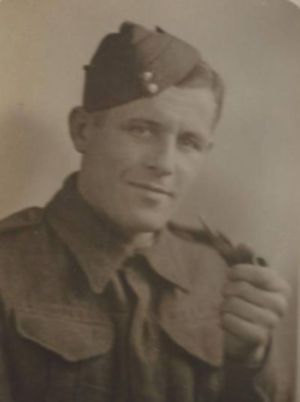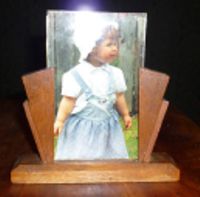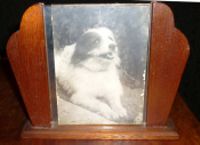Charlie Knell - Royal Corps of Signals
 Charlie Knell was born in 1918 in Abbey Street, Faversham, Kent. He worked at an engineering company in West Street Faversham as a teenager where he learned from one of the old engineers how to use geometry and algebra to draw and cut metal plating to produce certain shapes. This stood him in good stead later when he became a carpenter and in a roundabout way was to save his life when WWII loomed. In 1937/8 he had been working on the construction of Canterbury Hospital. Digressing from the story somewhat, as a huge coincidence his great granddaughter Leyla was born seventy years later in the same ward that he built… and actually on his birthday. Whilst working at the hospital he was involved in an industrial accident, he was standing on the scaffolding when a large iron cement bucket was dropped from an upper floor, and it crashed onto a plank which came up and hit Charlie under the chin smashing his jaw. He was eventually sent to East Grinstead in Sussex where he was operated on several times by Archibald McIndoe, the then little known pioneering surgeon into skin grafting and bone reconstruction. After his operations McIndoe showed the film and photographs to Charlie that he had taken during the procedures. As part of the reconstruction he had a silver plate set into his left cheek which he still has to this day. (His, along with Charlie’s records are now lodged in the East Grinstead Museum).
Charlie Knell was born in 1918 in Abbey Street, Faversham, Kent. He worked at an engineering company in West Street Faversham as a teenager where he learned from one of the old engineers how to use geometry and algebra to draw and cut metal plating to produce certain shapes. This stood him in good stead later when he became a carpenter and in a roundabout way was to save his life when WWII loomed. In 1937/8 he had been working on the construction of Canterbury Hospital. Digressing from the story somewhat, as a huge coincidence his great granddaughter Leyla was born seventy years later in the same ward that he built… and actually on his birthday. Whilst working at the hospital he was involved in an industrial accident, he was standing on the scaffolding when a large iron cement bucket was dropped from an upper floor, and it crashed onto a plank which came up and hit Charlie under the chin smashing his jaw. He was eventually sent to East Grinstead in Sussex where he was operated on several times by Archibald McIndoe, the then little known pioneering surgeon into skin grafting and bone reconstruction. After his operations McIndoe showed the film and photographs to Charlie that he had taken during the procedures. As part of the reconstruction he had a silver plate set into his left cheek which he still has to this day. (His, along with Charlie’s records are now lodged in the East Grinstead Museum).
In September 1939 when WWII started he was ‘excused boots’ as the saying went, in other words being a carpenter he was in a reserved occupation and he could not be called up, certainly for the first eighteen months anyway. He was employed making the shuttering to pour and construct the concrete anti invasion tank traps and gun emplacements on the beaches at Leysdown on the Isle of Sheppey. Some of these can still be seen today some seventy years on (the tank traps, or teeth are being used to stop cars driving onto the sea wall and gun emplacements are falling into the sea). On the beach the workers had a large piece of pipe hanging on a rope and as soon as aircraft were heard approaching they would bang this to give warning of air raids to everyone. They had a trench dug nearby with a sheet of iron over it to shelter under. German fighters were apt to strafe the beach with machine gun fire. By 1942 most of the defence works were complete and in fact probably not now so urgently needed as the threat of invasion although still there was not thought so likely, so he finally received his call up papers. He was to join the Royal Corps of Signals as a linesman and report to Catterick Camp in Yorkshire for his basic training.
“Men!” the instructor said to them “You are now gentlemen of the Royal Corps of Signals and you will conduct yourselves as such. You will remain smart at all times, even if you have only a piece of broken glass and a puddle of water you will shave every day.” He was taught to ride a motorcycle and how to lay cables from the rear of a moving lorry, by just throwing them over bushes as they drove along. They were taught how to erect an eighty foot radio aerial by a cantilever method in just three minutes and connect it to a mobile telephone exchange, having sent a message they took only three minutes to dismantle it and move off perhaps ten miles up the road. This prevented the enemy from getting a radio fix on their position. They were taught fundamental electronics. Later, whilst training out in the field he found by climbing a telephone post and clipping a phone onto the telephone lines he could ring and speak to his wife, Molly back at home in Teynham. She didn’t have a phone but he could arrange for her to be near one at the local shop at a certain time. The next ‘luck of the draw’ towards his eventual survival was that at the end of the course when the postings went up he found he was to go to a base in Taunton in Devon. Many of his friends and class mates were to be attached to various regiments that were due to go overseas. Some went never to return, such are the fortunes of war.
The building he was sent to was an old malt house which had been commandeered by the army. The next move to his eventual survival came when he found a brand new carpenters tool kit in the army store in the cellar. At about that time a soldier had reversed his lorry into something and smashed the wooden tail board, to save the man being put on a charge Charlie approached the Sergeant and offered to repair it; no one would know the difference. He took all the metal work off the smashed remains and made a new one, using the existing metal parts. The Sergeant then asked him if he could make a small notice board. Normally he could have knocked this up in an hour or so… but it took him three days. The reason being was that he was actually making wooden toys for his and his mate’s children. Children’s manufactured toys were impossible to come by during the war because of the shortages of materials and manufacturing, he made toy tanks, using 0.303 bullets for the gun barrels, forts, castles, air planes and other items. This came to the notice of the Sergeant who then asked him to make some for his children, and then it came to the notice of a couple of the officers… who wanted toys for their children! As a result of this they weren’t in a hurry to move him on! All the scrap wood and off cuts that weren’t used for toys went on the old pot belly stove to keep them warm, it was a hard winter.
In Devon the severe winter weather with six inches of snow brought down the telephone lines, the Royal Corps of Signals were employed repairing them. As the saying goes ‘All good things must come to an end’ and in the early part of 1944 he eventually got involved in training for D-Day. In preparation there was to be an exercise lasting several days and would be spread over several counties. They had been three days with virtually no sleep; they had travelled from Devon up to Lincolnshire laying cables as they went. In the early hours of one morning whilst travelling along a long straight road in Lincolnshire, the man driving the lorry that he was in fell asleep at the wheel and the lorry went straight over an embankment, rolling over several times. He came too with his arm trapped under the cab where it had been flung out the window as they went over. There was a smell of petrol and he feared that if the long grass ignited he would not get out. As luck would have it the next person along the road was a midwife on her bike, she had been called out during the night for a delivery. He instructed her to get two large branches lying nearby and by using one as a lever over the other and by sitting on it her weight could lift the cab sufficiently for him to get his arm out, he could then extricate himself.
Later they found his rifle, which had been alongside him in the cab, and which had gone through the circular canvas observation cover in the cab roof had been buried in the ground, when they got it out the barrel was bent almost double. His right forearm was shattered and had to be reconstructed. Strange as it may seem this was to be another bit of luck towards his survival. He was eventually discharged from the hospital but with his arm not fully repaired he was placed temporarily on light duties when the time came for the D-Day invasion. It was suggested that he could drive lorries but because of his recent experience and the break in his arm still being green they thought better of it. “I know” said the drafting Sergeant, ’We’ll make you a switchboard operator’. He was sent to Fort Widley at Portsmouth and was given a green security card which allowed him into the top secret communications centre in the tunnels under Fort Southwark. On the switchboard, amongst others he was putting Winston Churchill through to Ike, he recognized their voices but as soon as he connected them they said ”Put the scramble on old man”.
One morning coming off night duty he emerged from the tunnels to find the whole invasion fleet, which could be seen from up on the hill… had gone. The D-Day landings had started. Even being on the switchboard he was not aware of the date of the invasion. Many of the signalmen with whom he had trained and who took part would not survive the invasion beaches, the whole first row in one of the invasion cemeteries are signalmen. Charlie’s luck had held again. One day shortly afterwards he was ordered by a Sergeant, who he didn’t get on with, to stand guard duty that night on the camp perimeter… again, he tried to protest but to no avail. A short while later the same day whilst crossing the parade ground he happened to pass the surgeon who had mended his arm. He called Charlie over to him and said “And how is the arm now?” Charlie said “Not too bad sir, but the plate in my cheek is aching when it gets cold”. The surgeon asked him how many children he had now and Charlie told him four. He told him with the war as good as over and with his injuries and with a family at home his place was providing for his children. He told him to pack his kit, get a railway warrant and make his way home. As he was marching across the square to leave, the Sergeant bellowed across to him “Where do you think you are going Knell?” Charlie waved the railway warrant at him and said “I’m obeying the last order Sergeant… I’m going home.”
On arrival back at home, 17 London Road, Teynham, he and the other men of the village who had served in the forces were presented with a Mapin and Webb silver plated drinking tankard. (which has been the subject of previous articles).
Charlie went on to have eleven children who he provided well for by working long hours initially as a carpenter on war damage repair at Deal and Dover. At Deal during his lunch break he made photo frames, these he made from recycled ‘bomb damaged’ furniture, the glass was cut from broken windows as materials were still scarce. He sold them in Mr. Wigg’s shop at the top of Teynham Lane (Station Road). The small ones were sold for 7/6d (37.5p), Mr. Wigg took 1/6d (7.5p)and Charlie had the 6/-s (30p). He made more money from selling these than he earned in a week’s wages. (I wonder how many of these still survive?)
 Two types of picture frames produced and sold by Charlie, the little girl is his great granddaughter in New Zealand and the dog was his pet dog ‘Bob’ that he had as a young boy in the 1920’s.
Two types of picture frames produced and sold by Charlie, the little girl is his great granddaughter in New Zealand and the dog was his pet dog ‘Bob’ that he had as a young boy in the 1920’s.
During the war and for a few years afterwards paper was virtually unobtainable except for essential use, so Christmas paper chains could not be bought. Charlie made his own chains by setting his wood plane deep and making shavings from a piece of wood nine inches long by three quarters of an inch thick. He tied the shavings into bundles and dyed them over night in different colours using ‘penny dyes’. He placed a glue pot on a table and his children glued the strips into chains of alternating colours. The chains were then hung from the light rose in the ceiling to the picture rail in the corners of the room.
With his experience in his trade he worked on constructing the bridges on the M2 motorway and over the Medway. With the skills he learned at the engineering works as a teenager he constructed many complicated buildings including the wooden shuttering for hexagonal water towers and sewerage works.
He had survived, was it luck or fate? At the time of writing he is 96 years old.
Barry Knell
Charlie Knell passed away peacefully on the 1st November 2017 in a Whitstable nursing home aged nearly 102 years.